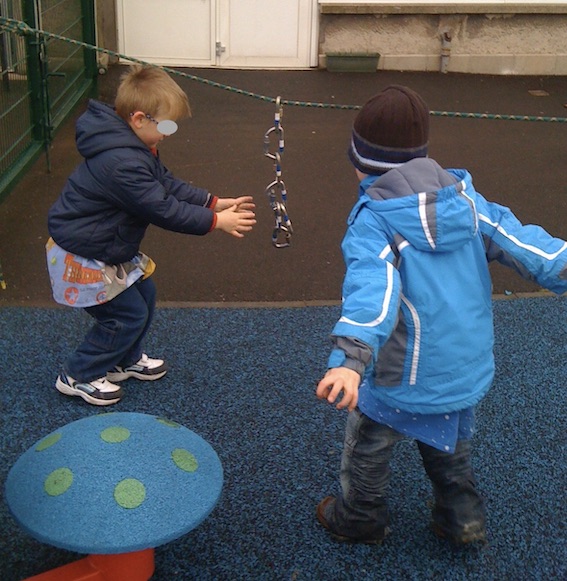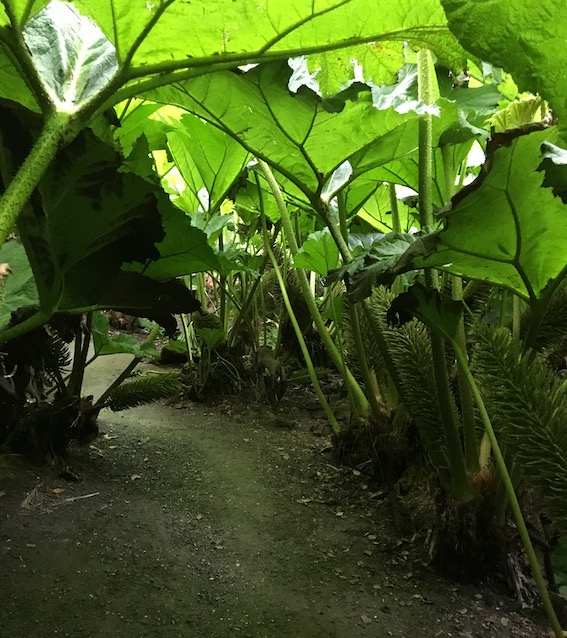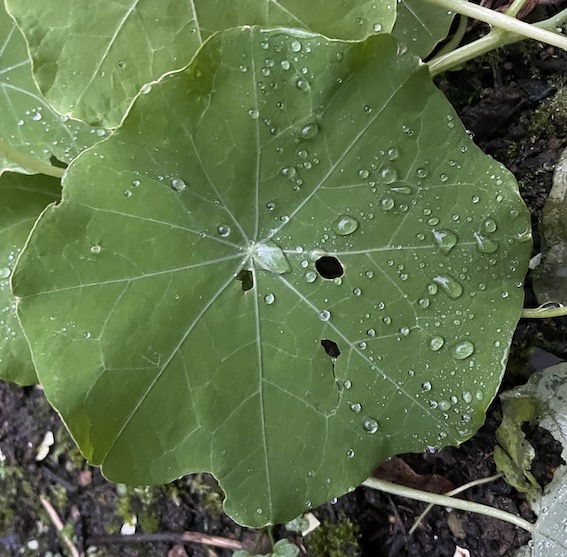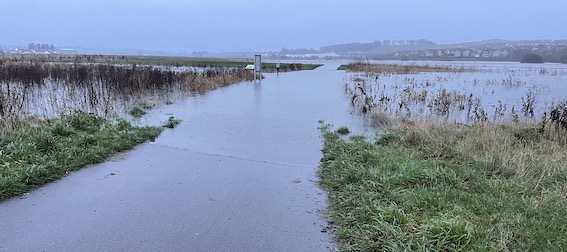Wet rainy days provide experiential learning opportunities like no other.. Rather than stay inside and suffer cabin fever, there is lots of fun to be had, donning the boots, waterproof clothes and heading out into the rain. Below is a collection of the blog posts and other ideas for making the most of rain. Remember to link this to children’s interests and needs. Plan responsively to what they like and want to do outside. Many of the ideas below require minimal advance planning or resources.

1. Why play in the rain?
- This is a great question to ask children, parents, staff and other visitors especially during a bout of rainy weather. Build up a shared understanding of the benefits. You can easily link this to the curriculum and have a display or video snippets where children are dropped off or picked up.
- Alongside this, ask for practical advice: for example, what clothing do we need to remember to wear? What’s a top tip for drying outdoor clothing? Then everyone is involved in developing the collective knowledge.
- Parents and staff can also be great for sharing memories of playing in the rain as children. These can be video comments that are played for all to enjoy on a loop in the cloakroom. If you have a large interactive whiteboard then I’ve found children love seeing photos and videos of themselves too. So this is a way of raising interest about all the outdoor possibilities that exist.

2. What is rain and why is it important?
This is can be a helpful part of everyday conversation with children as they play outside in the rain. Keep a record of questions that are asked to share with other children. Often they can lead to some lovely experiments such as how to make clouds or finding out what happens when plants don’t receive any water or too much water. You may also want to document the conversations in some shape or form too.
- Have a discussion about rain and how it helps us. What do we feel like when it rains?
- Look at the surfaces outside. Which can absorb rain, which become slippery?
- Get children to think of advice for others about being outside in the rain: what to wear, where to go, how to move, etc.
- Where and how can we make the biggest splash outside?
3. Exploring raindrops close up
- Take an absorbent sheet of paper such as blotting paper, newsprint or kitchen roll.
- Hold it out in the rain to catch a few raindrops. What do you notice? Think about the size, shape and spacing.
- What happens if you cover a sheet of paper with paint and hold it outside?
- Alternatively, leave an ordinary piece of paper outside to get really wet. Then see what happens if the children use a dropper to add tiny amounts of diluted food colouring. What happens if you sprinkle powder paint onto the sheet?
4. Collecting rain
If you have rain forecast, it can be fun to leave out a variety of different sizes and shapes of containers. Ask the children to predict which container they think will collect the most water and why. Discuss how you will measure the amount of rain that has fallen. The next day have a look, measure and check to see if your predictions are correct.
5. Sheltering from the rain
Where can we find shelter from rain? Look for places outside:
- is it drier or wetter under a bush or a tree than in the open?
- Are there any artificial shelters such as porches or dens?
- Take a moment to stop, pause and listen to the rain and what it sounds like too.
- What is the driest walk you can take on a wet day?
- Is it possible to make a waterproof den using only natural materials?
6. Which trees are the best rain protectors?
Do some trees or plants provide better shelter from the rain than others? If so which ones work best. A visit to a mixed woodland, a park with a variety of tree species or a botanic garden can help with this investigation? Encourage your group to look at the spread of the canopy, the height of the tree, the shape of the leaves and whether they overlap each other when looking up through the tree canopy. If your group visits a local woodland regularly they may already know the best shelter tree.

7. Bring out the tarps
Tarps and wet weather go together like bread and cheese.
- Transparent tarp allows children to observe the movement of water and raindrops in different ways.
- Other tarp can be used to make splash pools that can capture rain in interesting ways to play with at ground level.
- Put up a tarp at just above children’s head height so they can walk underneath but have to stretch to reach it or use a stick. The tarp will begin to sag with gathering rainwater. Wait and see if your children notice this and what they decide to do… the joy of discovering how to make the water pour off the tarp is wonderful to observe.

8. Raindrop races
Follow a raindrop down a window or a transparent tarp. What happens to it? Have a raindrop race with a friend. Pick a raindrop at the top of the window/tarp and see which one makes it to the bottom the first. Have a look at how raindrops move over a tarp and see whether the different material affects the formation of droplets running down it.
9. Finding raindrops on plants
Look at how different leaves cope with raindrops landing on their surface. Some, like the nasturtium leaves in the photo below concentrate water droplets. They have thick waxy cuticle and fine hairs that allow water to bead and run off. Teasel leaves are angled downwards, joined and cupped around the stalk to collect water – hence its other name Venus’ basin . You may be lucky enough to see a small bird come and drink from these cups.

10. Channelling the flow of water
The wet weather is ideal for creating water walls of different sorts and complexities, depending on the age of the children and the particular design challenge in mind. Guttering is also useful for channelling water horizontally as well as vertically. Use Skitch and other photo apps to help children explain their designs to others.
11. Rain dancers
Chose a wet day. Dress up in waterproof clothing. Grab an umbrella and get those rain dance routines perfected. Remember puddles make great wet stages for a good rain stomp. Try and tap dance in time to the rhythm of the raindrops. Find out more about gumboot dancing.
12. Catch raindrops with your tongue
How many raindrops can you catch on your tongue? How many do we catch all together and how can we find this out?
13. The sound of rain
Experiment with the variety of sounds that rain can make by putting different sorts of bowls on top of your head and listen to the raindrops landing . Which bowls make the loudest and softest sound? Compare this to the sound of a rainstick? Think about whether all rain sounds the same.
14. The power of rain
If you have children who enjoy moulding and sculpting sand, then set up a place where they can create a small world. Take a photo of their work. Then let the rain pour down overnight. The next day look and see if any changes have happened as a result of the rain. Take another photo and compare – what’s stayed the same and what’s now different?
15. Rain patterns
Look for patterns in the rain. Rainy days rubbings using tin foil allow an alternative way of exploring texture and pattern outside. What patterns does rain create? Can you see any evidence after it has stopped raining?
16. Where does rain water go?
Find out where rain collects and what happens to it. Look at guttering, drains, water streaming along the side of a pavement, soaking into grass, etc..
Go for a walk and look at where water can be found in the local area. This is the start of understanding how water moves through our ecosystems. This is especially good on a wet day where water can be seen pouring down pipes and into drains, exploring puddles and wondering where water ends up.
Look for evidence of water control measures outside. Good examples include guttering, drains, channels, flood protection measures, the landscaping at the seaside such as sea defence measures, etc.
17. Fake puddles
Make a puddle when it rains – Can you do a better job than nature? Look at where puddles form and how. Is it always a result of rain falling or is there other sources of water? Is it possible to increase the size of a puddle?
18. Floods
If your children live in a place that experiences flooding, then be aware of which children may have been affected.
- Do their families have a safe place and sufficient support or do you need to act to ensure the family receives this?
- Talk about the help and support we can give to people who have been flooded out of their homes, if this has happened locally. Give time for children to ask questions and express their feelings. Some may be impressed by the powerful effects of flood water. Some may be frightened. Read stories that reassure children or make them up to help children make sense of their feelings.
- If it is safe to do so, it may be worth visiting places which have been flooded so that children can see the effects. Talk about the impact – wonder where all the animals and birds may have gone that lived here.
- We can slow down the movement of water through the watershed by planting trees and gardening as plants hold onto the water and slow down the speed at which it moves into the ground, through the ground and into our streams and rivers.

19+. Other suggestions linked to rainy days
- 10 puddle play investigations blog post has lots of ideas for exploring puddles at all ages. Integrate them into science experiences around water.
- Create rain chains to gather water from a shed roof.
- Have a look at the design of this interactive palette play station at Stramash Fort William to see a large scale water exploration area.
- Download the Exploring Water Outside handout.
This blog post was originally published in February 2014.




















Some great ideas there #CountryKids
Fantastic post as always, will definitely be trying some of these 🙂 x
Lots of ideas to inspire outdoor fun during the wet spell we are having. Thanks for linking up and sharing your ideas with Country Kids.
Some super ideas 🙂
What a fantastic list – I have bookmarked them for future reference! Now I am just hoping that February is dry and it’ll be a while before we need this list!
Lots of good ideas. 🙂
These are all great ideas. It can be so tempting to stay inside when the weather is bad but I’m feeling the challenge to do some of these instead! #countrykids
Great ideas & made me get the clear tarp out this week! Thanks for supporting the OPP too.
Thanks so much for sharing this wonderful ideas at the Outdoor Play Party. They are fab! 🙂
What a great collection of ideas. Thanks for linking to the Outdoor Play Party
Several good ideas listed here. People often see the rain and choose to let the weather end their plans, but you have offered a variety of fun activities to consider. Make sure you have a good pair of muck boats and waterproof clothing and go have yourself a blast!
These ideas sound fantastic! Rainy days can be a ton of fun outside as long as the right clothing and boots are in place. So, make the most of it by going outside and making some memories!